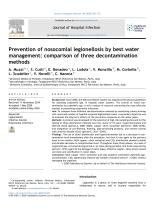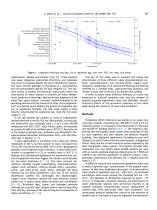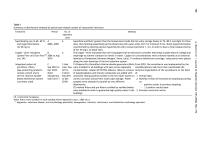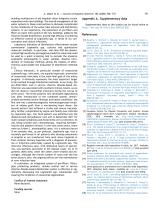 Website:
NUOVA SB SYSTEM
Website:
NUOVA SB SYSTEM
Group: Nuova SB System
Prevention of nosocomial legionellosis by best water management: comparison of three decontamination methods
1 /
7Pages
Catalog excerpts

Journal of Hospital Infection 105 (2020) 766-772 Available online at www.sciencedirect.com Journal of Hospital Infection journal homepage: www.elsevier.com/locate/jhin • Healthcare ; Infection • Society Prevention of nosocomial legionellosis by best water management: comparison of three decontamination methods A. Muzzi a,% S. Cuttia, E. Bonadeoa, L. Lodolaa, V. Monzillob, M. Corbellab, L. Scudellerc, V. Novellia, C. Marenaa a Direzione Medica di Presidio, Fondazione IRCCS Policlinico San Matteo, Pavia, Italy bMicrobiologia e Virologia, Fondazione IRCCS Policlinico San Matteo, Pavia, Italy cDirezione Scientifica, Unita di Epidemiologia Clinica, Fondazione IRCCS Policlinico San Matteo, Pavia, Italy ARTICLE INFO SUMMARY Article history: Background: Since 2000, the National Health System has adopted international guidelines Received 11 November 2019 for assessing Legionella spp. in hospital water systems. The control of water con- Accepted 1 May 2020 tamination by Legionella spp. is still a matter of research concerning the most effective Available online 8 May 2020 method in preventing nosocomial infections. _ Aim: To compare three different decontamination methods by monitoring colony-forming Keywords: unit count and number of hospital-acquired legionellosis cases. A secondary objective was Legionellosis to evaluate the long-term effects of the preventive measures on the water pipes. Chlorine dioxide Methods: A protocol was developed for the selection of high-risk sampling sites and for the Nosocomial infections testing of three disinfection methods over the course of 19 years: hyperchlorination and thermal shock (period A, 2000—2005); copper—silver ionization (period B, 2006—2010); and integration of pre-filtering, filtering, pipe-protecting products, and remote control with chlorine dioxide (ClO2) (period C, 2011-2018). Findings: The use of shock disinfection and hyperchlorination led to a decrease in contamination level immediately after the procedure, but then it rose again to the previous level in two months. Both copper-silver ionization and ClO2 disinfection showed a stable and durable decrease in contamination level. Throughout these three phases, six cases of Legionella spp. occurred during period A, six cases during period B, and three cases during period C. With regard to the damage of water pipes, effective copper—silver levels caused corrosion and calcification in water pipes. Conclusion: Both copper—silver ionization and ClO2 properly controlled Legionella spp. contamination. ClO2 significantly reduced the number of positive sites (P < 0.001) without damaging the pipelines. © 2020 Published by Elsevier Ltd on behalf of The Healthcare Infection Society. Legionella is a genus of Gram-negative bacteria that is widespread in nature, and in humans responsible for Introduction * Corresponding author. Address: Direzione Medica, Fondazione IRCCS Policlinico San Matteo, Pavia, Italy. Tel.: +39 (0)382 502268/ 503419. (A. Muzzi). E-mail address: a.muzzi@smatteo.pv.it (A. Muzzi). https://doi.org/10.1016/j.jhin.2020.05.002 0195-6701/© 2020 Published by Elsevier Ltd on behalf of The Healthcare Infection Society.
Open the catalog to page 1
A. Muzzi et al. / Journal of Hospital Infection 105 (2020) 766e772 Specialty department New building opened December 2013 Internal medicine/General surgery Orthopaedics Ophthalmology Palliative care Infectious disease Respiratory medicine Paediatric unit Haematology ENT Private care facility Obstetrics and gynaecology Legionella case Figure 1. Legionella infections and log10 cfu of Legionella spp. over time. ENT, ear, nose, and throat. Legionnaires’ disease and Pontiac fever [1]. These bacteria may cause dangerous nosocomial infections, and outbreaks may occur in hospitals despite the use...
Open the catalog to page 2
Table I Summary of disinfection methods by period and related number of nosocomial infections legionella cases system Flow cell (Tarn Pure™ 2006 to Aug Ltd, UK) 2010 Integrated system of pre-filters, filters, pipe protecting products, remote control and in service chlorine dioxide-based disinfection system (currently used) C Sep 2010 to Dec 2018: Multidisciplinary task forcea) 3 (last case: Sep 2011); 0 (from Sep 2011 to Dec 2018) Superheat and flush: greater than the temperature inside the hot water storage heater at 70—80°C overnight for three days, then flushing sequentially all the...
Open the catalog to page 3
A. Muzzi et al. / Journal of Hospital Infection 105 (2020) 766—772 in given sites and clinical units admitting high-risk patients (i.e. intensive care unit, transplant unit, haematology). Three calendar periods were considered, according to the biocide method applied. Period A, from 2000 to 2005: superheating (to 60°C) and hyperchlorination (to 50 ppm); period B, from 2006 to August 2010: copper—silver ionization system (Flow cell; Tarn Pure Ltd, High Wycombe, UK, employed for the whole waterline in period B); period C, from September 2010 to December 2018, after installation of 15 Oxiperm...
Open the catalog to page 4
A. Muzzi et al. / Journal of Hospital Infection 105 (2020) 766—772 Table II Legionella spp. contamination according to the disinfection method Total no. of tested samples Samples <1000 cfu/L Maximum cfu/L Samples >1000 cfu/L p50 median (IQR) No. of isolates Serogroup 1 Serogroups 2—14 IQR, interquartile range. Period A: Jan 2000 to Dec 2005; period B: Jan 2006 to Aug 2010; period C: Sep 2010 to Dec 2018. (32.28%); the remaining 193 samples tested negative. During this period, the number of positive supply points and the bacterial loads decreased progressively, but the registered decline of...
Open the catalog to page 5
A. Muzzi et al. / Journal of Hospital Infection 105 (2020) 766e772 building architecture of old hospitals often integrates recent expansions with new buildings. The overall management of the water systems in these constructions is obviously complicated by the complexity of the water tube network and disinfection systems. In our experience, the placement of pre-filters and filters on water entry points in the new buildings, added to the chlorine dioxide disinfection, proved high efficacy in achieving an effective control of Legionella spp. in terms of cfu concentration and clinical infections....
Open the catalog to page 6All NUOVA SB SYSTEM catalogs and technical brochures
-
GANDY I.E LINK
11 Pages
-
GANDY ESC H.9
8 Pages
-
TERMINAL FILTRATION BROCHURE
2 Pages
-
Gandy Endoscope Washer Device
16 Pages
-
Terminal Filtration POU 62 Days
12 Pages












